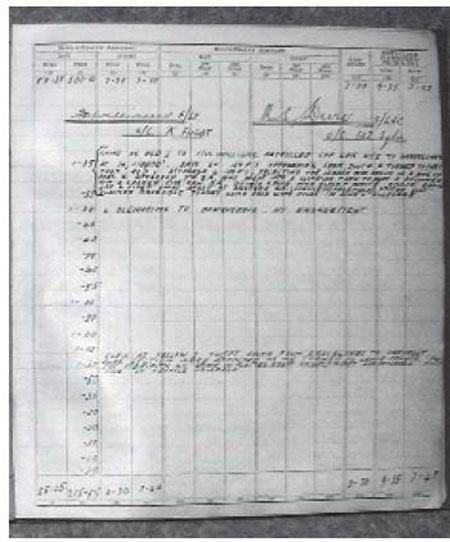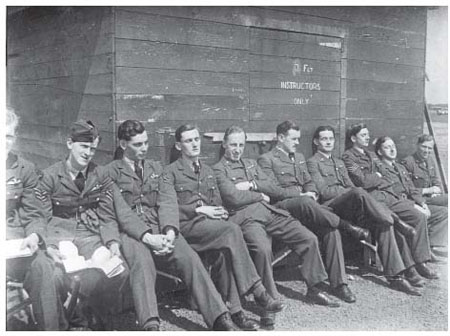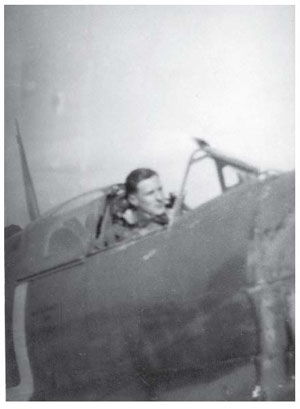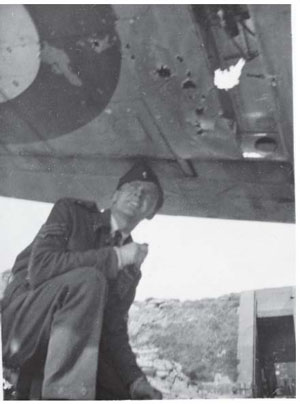A Very Unusual Air War (13 page)
Read A Very Unusual Air War Online
Authors: Gill Griffin

1 October
: I was flying as Red 2, wingman to F/Lt J.D. (Johnny) Williams. We patrolled inland from Cap Gris Nez to Gravelines at 14 to 15,000 feet. We somewhat cautiously watched 6-plus ME 109s on a climbing approach from the south. Being in a favourable position, up sun and with a height advantage, we turned to meet them. Red 1 attacked the leading four of the 109s, selecting the leader who broke away in a steep dive to port. I followed him and opened fire; the e/a then went into a steeper dive with black and white smoke pouring out. I broke off and fired a short burst at a second e/a. As neither of the e/a’s was seen to crash, I only claimed and was given, 1 probably destroyed. Sergeant Smith also claimed a ‘probable’. Johnny came home with bullet holes in the wing and fuselage of his Spitfire. A lucky escape!
3 October
: When escorting bombers, the supporting Wings would normally take up one of three positions:
Close escort
immediately above or around the bombers.
Escort cover
stepped up above the close escort or
High cover
could be 1,000 feet or more above the other participants. On a big ‘show’ more than one Wing could be stepped up to further heights in support of the operation. The operation on the 3rd was to escort six Blenheims to Dunquerque for an attack on enemy shipping. No engagement.

Extract
from logbook for 1st to 3rd October 1941, signed by F/Lt Johnny Williams and S/Ldr Al Deere, showing an action in which F/Lt Williams returned with bullet holes in his wing and fuselage.

10
October
: A short visit to Hullavington to chat with my old instructors.
12 October
: On this operation I flew as Yellow 3, sub-section leader on the port side of the leading section and slightly above it. We swept south from Gravelines to Hardelot, inland ten to fifteen miles from the French coast. Blue section, off to our right and slightly below us, were attacked by a group of 109s just as we made a starboard turn to leave France. The rest of us were immediately involved in several brief individual combats and for a few moments the sky seemed full of aircraft. In a momentary lull I saw Blue 4 off to my right spinning down, with the Spitfire completely engulfed in flames. I broke violently to port to avoid an attacker and became separated from the somewhat scattered squadron, so joined up with one of the ‘Keyhole’ (452 Australian) Squadron boys and got home safely. We later learned that Blue 4 was Sergeant Ted Meredith of B Flight and at that time he was believed to have perished in his flaming aircraft.
45 years later, in March 1987, I was chatting with the husband of one of my wife’s friends. He noticed my RAF Association lapel badge and asked what I did in the RAF. Learning that I had been a fighter pilot, he told me of a friend who had also been a fighter pilot, named Ted Meredith and wondered whether I knew him. I said that I had known a Ted Meredith but it could not be the same chap, as I saw him shot down in flames. A quick phone call revealed that it was, indeed, the man I had known; not only was he alive and well but lived only eight miles away in Bromsgrove! Ted was a Freemason like me and we agreed to meet at the next meeting of his Lodge. A mutual friend tipped off a reporter of the local newspaper. The story not only appeared in the local papers but also made headlines in the
Daily Express
. A few days later we were interviewed by a team from the BBC. Instant fame! Ted and I remained friends until he really did die, in 1996.
15 October
: My second trip on the 15th to Tangmere, was intended to be a visit to 41 Squadron but they had moved on. I did a quick hop over to Merston but again I was unlucky as they were airborne on a sweep.
The operations over France, Belgium and Holland were intended to carry the offensive to the Germans, to give some comfort to the occupied countries, as well as to tie up large numbers of the enemy forces. The various operations were given code names.
Rodeos
and
ramrods
were usually attacks against enemy shipping or specific land targets. A
fighter sweep
was a penetration into enemy-held territory with or without bombers. A
circus
involved a large number of fighter planes, as many as seven or eight Wings, each of three squadrons, the latter with strength of twelve aircraft, as cover for short-range bombers. A
Balbo
, named after the Italian general, would be even larger, including formations of light bombers. A
Rhubarb
, described earlier was a two-man operation over enemy-held territory looking for targets of opportunity.
17 October
: Through September and October the Focke Wulfs continued to appear in ever increasing numbers and our losses increased at an alarming rate.
Worsening autumnal weather plus the heavier losses resulted in a curtailment of our operational activity. In November I flew only four operational trips and one of those was aborted by bad weather.
20 October
: Camera gun practice was really mock dogfights between squadron members.
21 October
: ‘Fighter sweep.’ I flew as Blue 3 with Sgt Quinn as my No. 2 (position now known as Wingman). The Squadron carried out a sweep – Hardelot–St. Omer–Boulogne. Just before leaving France, at about 15,000 ft, I became separated from the Squadron and went down to join up with 3 aircraft, on a westerly heading, thinking them to be Spitfires. They turned out to be 109s; the pilots had apparently not seen me. I attacked the lowest of the three, firing two bursts from the left quarter astern. I saw holes appear and my cannon shells bursting down left of the fuselage; a piece fell off the left wing. I broke away to port and came home (flat out). I claimed and was given one Me109 probably destroyed.
This sweep shows my progress in the squadron, being now considered sufficiently experienced to be a sub-section leader, the first occasion being a week earlier on the 12th. Initially my No. 2 would have been another NCO pilot but within a short time it was not unusual for a new officer to be in that position. I was considered to be a ‘safe’ pilot and most new boys, both NCOs and officers, made their initial sector experience flights with me.
My experience that day echoes a well-known RAF story: ‘Having been separated from the rest of my squadron, I dived to join three Spitfires … Looking up from my dinghy five minutes later, I saw that they were Messerschmitt 109s.’
‘Scramble.’ Our section of four Spitfires was scrambled to intercept enemy aircraft over the Channel. We patrolled at 24,000 feet for 1 hour 35 minutes and saw vapour trails above to the east but were unable to intercept.
30 October
: As well as sweeps, we also flew patrols over naval actions such as convoys and minesweeping. We sometimes flew as escort to little Walrus seaplanes and the fast surface AST (Air Sea Rescue) boats. On the 30th we escorted the Lysander, a special purpose aircraft initially designed for artillery spotting; however, by reason of its very short take-off and landing ability it was widely used, as on this occasion, for dropping or collecting agents into and from France.
31 October
: This was a low-level attack on shipping in and near the harbour, with bombing successfully carried out by Hurribombers. In this operation we all joined in with cannon and machine-gun fire at some of the lighter ships and dockside installations. This was a most dangerous proceeding as German low-level anti-aircraft fire was murderous. Several of our aircraft were hit and the wing leader, Wing Commander Ernie Ryder, was shot down. He was an ace from the Battle of Britain and his was a grievous loss.
| Summary for:- October 1941 | 1 Spitfire | 19–15 | |
| Unit:- | 602 squadron | 2 Magister | 8–40 |
| Date:- | 1/11/1941 | | |
| Signature :- | H.L. Thorne | | |
Pencilled notes. Operational hours to date: 57 hours 45 minutes
| Personal Score to date | 1 ME. 109 | Confirmed |
| | 1 | Probable |
| | 1 | Damaged |
| Signed Norman C. Macqueen F/Lt | A.C. Deere S/Ldr |
| O/C ‘A’ flight | O/C 602 Sqdn. |

602 Squadron. F/Sgt Les Scorer in the cockpit of his Spitfire.

Sgt Sanderson inspecting the cannon shell damage to his wing.

Johnny Niven, Jimmy Garden, Sgt Smith, Len Thorne.
| YEAR | 1940 | AIRCRAFT | Pilot or 1st Pilot | 2nd Pilot, Pupil or Pass. | DUTY (Including Results and Remarks) | Flying Time | Passenger | ||
| MONTH | DATE | Type | No. | Dual | Solo | ||||
| November | 1st | Magister | R1915 | Self | F/O Edsall | To Hendon | | –40 | |
| | | Magister | R1915 | Self | | To base | | –40 | |
| | 2nd | Magister | R1915 | Self | | To Hendon | | –25 | |
| | | Magister | R1915 | Self | F/O Edsall | To base | | –25 | |
| | | | | | | Grand total to date: 296 hours 40 minutes | 3–30 | 7–40 | |
| | | | | | | 55–25 | 230–05 | 4–40 | |
| | 7th | Spitfire | P8791 | Self | | Hurribomber escort | | 1–35 | |
| | | Spitfire | P8791 | Self | | Practice formation | | 1–10 | |
| | 8th | Spitfire | P8791 | Self | | Operational sweep | | 1–45 | |
| | | Spitfire | P8791 | Self | | Manston to Kenley | | –35 | |
| | 9th | Spitfire | AB848 | Self | | Squadron formation | | –55 | |
| | | Spitfire | W3638 | Self | | Dummy sweep (ops) | | –55 | |
| | 11th | Spitfire | AD515 | Self | | Sweep (wash out, bad weather) | | –45 | |
| | 15th | Spitfire | W3898 | Self | | Local flying | | –20 | |
| | | Spitfire | AD515 | Self | | Local flying | | –20 | |
| | | Spitfire | W3898 | Self | | Local flying | | –10 | |
| | 22nd | Spitfire | W3956 | Self | | Squadron formation | | 1–10 | |
| | | Spitfire | W3956 | Self | | Squadron (Pansy) formation | | –40 | |
| | 26th | Spitfire | P8799 | Self | | Air and cannon test | | 1–10 | |
